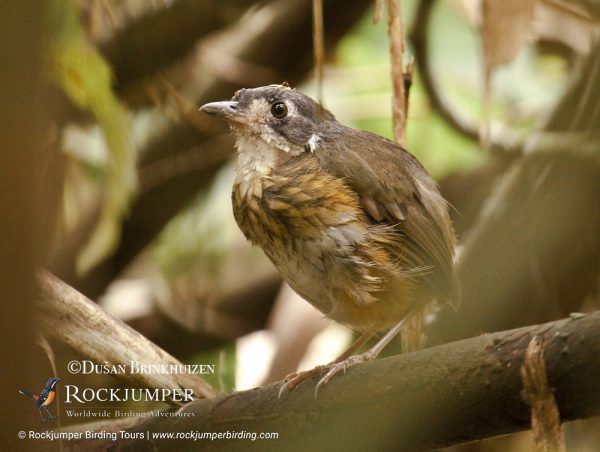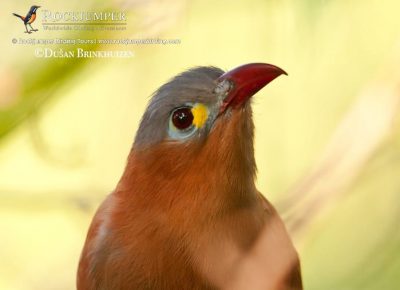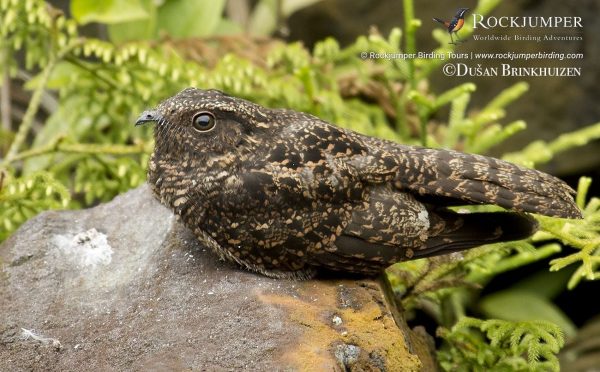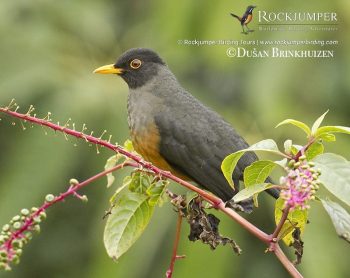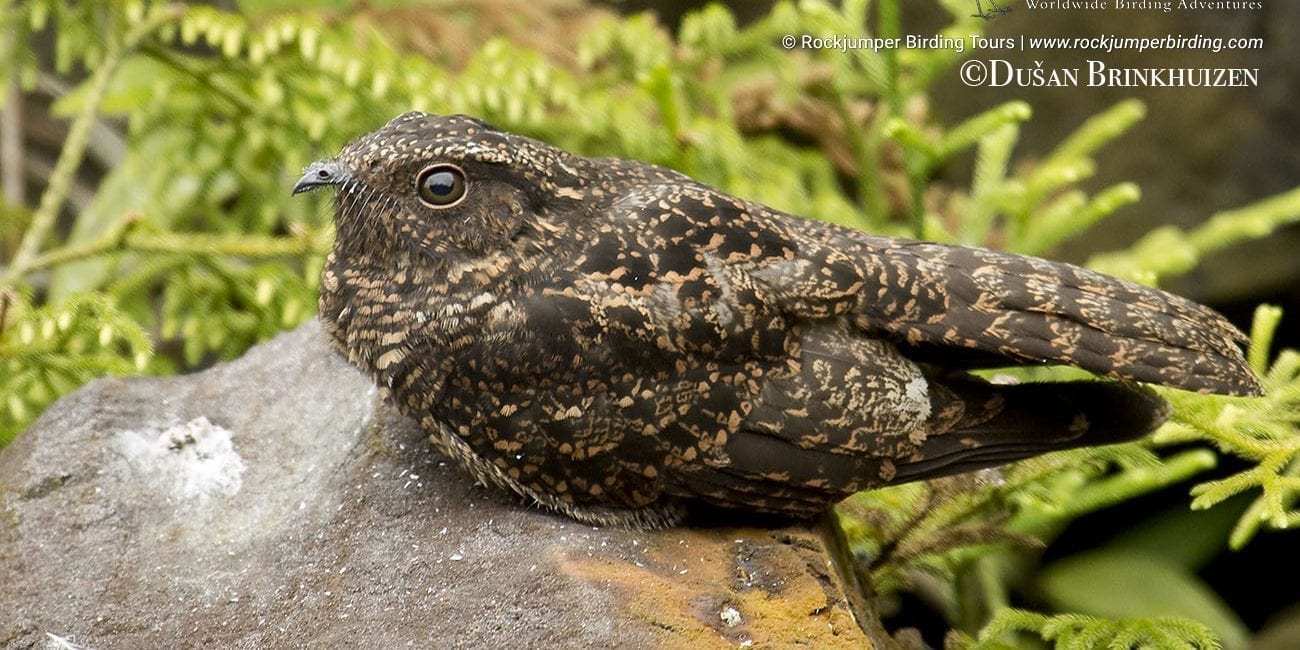
Among birders, it is widely thought that perhaps the greatest test of a birder’s field skills is during a “Big Day”, when a team of birders try to see as many bird species as possible in a single 24-hour period. To even have a chance at a high species total, all team members must possess great field skills, great logistical skills, and must also plan, execute and adapt the team’s route during the day. Field skills are key, but planning, and experience with the route are equally important.
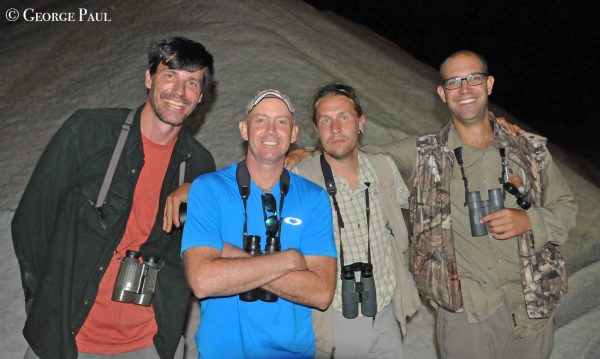
On 8 October 2015 in Ecuador, team members Rudy Gelis, Mitch Lysinger, Tuomas Seimola and Rockjumper’s own Dušan Brinkhuizen identified a total of 431 bird species within a 24-hour period, surpassing the magical 400 species boundary for the very first time in history; and in the process setting a new world record! They had hoped with luck and careful planning, a world title was possible, but none expected they’d best the previous world record by 77 (!) species. Below, veteran guide Dušan Brinkhuizen gives us a rundown on a history of Big Days past, and of and the magical day that was October 8th, 2015.
The Biggest Day: A New Record
By Dušan Brinkhuizen

Rockjumper Guide Dušan Brinkhuizen is based in Ecuador and guides to a great variety of destinations.
First, A Brief History
The world’s first famous big day record was set by the late Ted Parker and Scott Robinson on 30 September 1982. More than thirty years ago the two ornithologists conducted their count in pristine habitats of Amazonian lowland forest at Cocha Cashu Biological Station, Madre de Dios, in south-east Peru. Their effort was done by foot and canoe in a relatively small but mega-diverse area. During this legendary effort, with no use of any motorized transportation, Parker and Robinson tallied an astonishing total of 331 bird species.
This record stood until 30 November 1986 when Terry Stevenson and John Fanshawe performed a big day count in Kenya. Their team used two airplanes and nine vehicles during an amazing effort that recorded 342 bird species. More recently, a Louisiana State University team with Dan Lane, Mike Harvey, Glen Seeholzer and Fernando Angulo broke the long-standing Kenya record on 14 October 2014 (Seeholzer et al. 2015). The LSU team ended up with 354 bird species, beating the previous world record by twelve species. Seeholzer et al. started their count at Pomacochas Lake in the eastern Andes in northern Peru and continued down the east-slope by vehicle, ending their effort in the lowlands of the Moyabamba valley.
The success of the LSU team’s new record sparked renewed interest in the World Big Day concept among resident birders in Ecuador who had always been keen in attempting one there. The route in northern Peru also confirmed the great potential of the Andean east-slope, and was helpful in conceiving a route along the vast east-slope of Ecuador, which can be birded right along the equator.
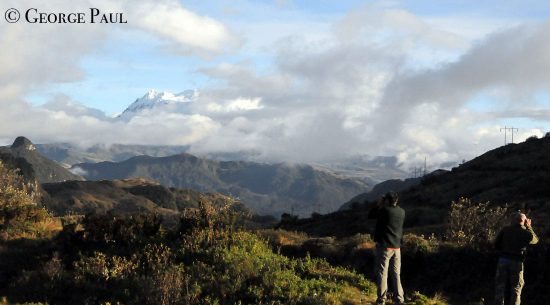
The team, route and preparations
Ecuador is arguably the most biodiverse country on the planet. The country’s bird list approaches a staggering 1,700 species. Peru, Colombia and Brazil boast higher totals but these countries are also much larger too. The mighty equatorial Andes harbor a unique range of ecozones, that occur as distinct altitudinal bands of rich tropical habitats, and in Ecuador from the Chocó in the west to the mega-diverse Amazon basin in the east, the proximity of these ecozones make for enormous, easily accessible biodiversity.
Designing the perfect big day route is not an easy task. For a few years we thought that combining both east and west would be the optimal way to go. However, with only 12 hours of daylight, time is a limiting factor. It would take at least eight hours just to drive from the Amazon basin to the western lowlands. Driving during the night between the two would allow a team to combine both ecosystems, but this setup would never work in a single calendar day.
We pivoted to the great potential of Ecuador’s east-slope along the Cosanga-Narupa transect. The annual Christmas Bird Counts held in Cosanga, Napo province, in recent years had seen claims of counts (with many teams of dozens of observers, spread out and working together) surpassing 500 species. For years our team members had been birding the eastern foothills and subtropics of this region (Rudy and Mitch even residing there), so we knew this was a key area. Unfortunately, construction of the highway from Quito to Tena has adversely affected the birding along this transect, but from a big day perspective, it was actually an advantage as driving times were halved from about eight hours to less than five.
In early March 2015, Dušan and Rudy picked up the topic of doing an Ecuador big day together and they came up with a simple conclusion: “let’s just do it”. In what ended up as a trial run for their record day, Tuomas Seimola had flown in from Finland, an enormous advantage, as Tuomas is an extremely skilled spotter. During this first effort, we learned the advantages of having a non-participating companion aboard. Peter Joost joined us, helping with many things like catering but conforming with ABA rules, he was not allowed to point out birds to us during the count. After a couple of days scouting Rudy, Tuomas and Dušan set out on 8 March, and while the night birding went well, the weather at the dawn chorus site was a disaster, with constant rain. Since we were all free the following days, we postponed our effort to the next day. At 13:00 we drank a few beers at Yanayacu Biological Station and since we had been birding intensely from midnight onward it was super easy to fall asleep. The alarms woke us up at 23:45 and because our internal clocks had been adjusted completely, we were more than awake and ready for another big day run! The weather was much better on the 9th and we tallied a total of 335 bird species. This first effort provided us bronze medal status, regarding the world title, but we knew with better preparations more was in store.
Over the coming weeks, another attempt on the record gathered steam. Rudy started a small fund raising webpage which worked out well and with the donations of friends, our second attempt came to fruition. Tuomas decided to fly over from Finland again, but there was no doubt we needed an extra pair of eyes and ears. As luck would have it, we were able to recruit “magic” Mitch Lysinger, an expert recordist and Ecuador birder, who was able to get time off and strengthen our squad. George Paul was invited also as a non-participating companion and official witness of the big day. He flew in from the US to document the entire 24-hour effort with high-tech recording and video equipment. By doing this, our big day effort would become auditable and more credible than non-documented efforts, thereby setting a new standard for serious world record big day attempts.
Optimizing the route was now a priority, as we knew we needed a much tighter schedule than we had in March. Time management on a big day is perhaps the greatest challenge. During scouting we specifically looked for active nests, roosts, fruiting trees and searched for backup territories for as many species as possible. We tried to get a better idea of the daily patterns and whereabouts of mixed-species feeding flocks. Especially during the last days prior to the count we birded almost as intense as we would do on the big day itself. These dry runs served as great training for our spotting and communication skills as a team.
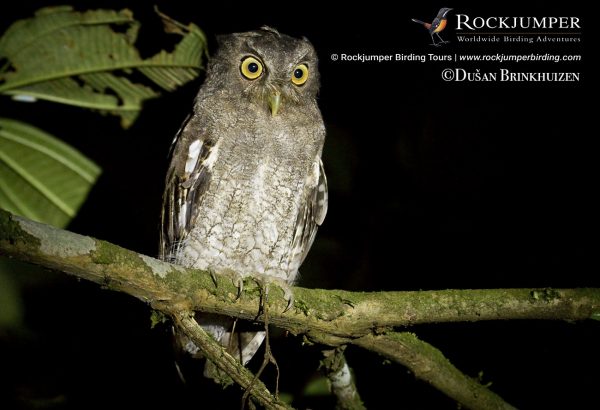
Even though our Amazonian trans-Andean route seemed solid, we felt the need of an extra strategy that would significantly increase our chances for a world title. The idea of including a flight intrigued, but with a flight, critical birding time is lost during check-in and while flying. Therefore, a flight during the least productive time of the day would be the best scenario, and in our case, this was the evening after dusk. But where in Ecuador do we maximize new species on our second session of night birding? After some thought, Dušan phoned Ben Haase, Ecuador’s sea- and shore bird expert living in Salinas, Santa Elena province, who was able to confirm that night birding in the local salt pans might be good. In the past, Ben had been banding shore birds at night and according to him there was plenty of bird activity, even after dark. Dušan and his wife Lorena scouted out Salinas three weeks prior to the big day. A night trip with Ben into the salt pans of Ecuasal was a huge success and in the moonlight they were able to identify over 30 species of birds! For a couple of nights the salt pans, mangroves and sea shore were scouted out and a so-called “power route” of 3 hours was designed carefully. Many of the bird species encountered were actually foraging at night and surprisingly the majority of them seemed to be site faithful too. For example, Willet, American Oystercatcher and Sanderling would typically forage on the beach, while the smaller Least and Semipalmated Sandpipers would be inside the salt pans. Apart from the aquatic birds, Dušan and Lorena searched the gardens and bushes in town with spotlights. It was extremely difficult to find sleeping birds during night time but waking up the house dogs and alarming the police was easy! In the end, we did find two roosting sites of Long-tailed Mockingbird and a roost of Red-masked Parakeets.
Based on the scouting we felt adding Salinas to the 2nd night was a good bet. But still we had to get there. And then, almost as if by fate, a quick check online revealed a single rare monthly flight from Quito to Salinas on 8 October at 19:30: the perfect timing for our big day. With only six seats left, decisions had to be made immediately, and after a few more phone calls the flights were booked!
8 October 2015, the big day
It was a special feeling when the alarm clock went off. We immediately looked outside the window: no rain and the sky looked promising! We met on the balcony of the San Isidro lodge lounge, and everybody was on time, awake and dressed, with great anticipation about the crazy and exciting adventure ahead! With ten minutes until midnight, George tested his microphone setup, and Mitch and Tuomas scanned with the spotlights, hoping to find perched birds. Then came the call, “OK guys, it is 0:00, 8 October 2015, our big day officially started”. Everybody was dead silent until 0:01.
Rufous-banded Owl, the first bird of the count, calling beautifully in front of us. A minute later, the Black-banded “San Isidro” Owl called behind us: check! We quickly went to the vehicle and double-checked everybody had their gear. The vehicle setup was: Rudy driving, Tuomas at co-pilot and front-spotter, Mitch and Dušan as side-spotters with George squeezed in the middle. 20 minutes were scheduled for the Andean Potoo search. Unfortunately, the bird eluded us, so we had to move on to our next target. At the Huacamayos pass Swallow-tailed Nightjar was not cooperating either, but a White-throated Screech-owl was a great consolation. Lower down the slope we got both Rufescent and Foothill Screech-owl singing nicely in response to our tape. Our next stop was a Band-bellied Owl territory. The previous night we had watched a beautiful pair at a streetlight but unfortunately this time there was a perched Black-banded Owl instead! It was a very nice sighting but the Black-banded Owl likely chased away our target owl, so we tried at backup sites further along Loreto road but with no success. A roadside nest of Blue-fronted Lancebill was a great find during scouting, and a quick check with the spotlight confirmed the presence of an incubating adult. Lyre-tailed Nightjar at the cliff was our next successful stop before heading down to the lowlands. Our owling session in terrafirme forest was a huge success. At a single spot we bagged Tawny-bellied and Tropical Screech-owl, Common Potoo and Spectacled Owl! The Nocturnal Curassow was singing much closer to the road than the previous night and listening to its booming call over the Amazonian rainforest was truly a magical moment. White-throated Tinamou and Crested Owl were heard nicely but we couldn’t find Great Potoo. After tape playback at a backup site, a beautiful adult Great Potoo flew overhead in the spotlights. Another magical moment!
16 species at 4:49.
At 4:49 we continued towards the magnificent Rio Napo. A short stop at the airstrip got us a huge bonus species: a Barn Owl perched atop a fencepost! Hoatzin was picked up at a small swamp according to schedule a couple of minutes before reaching our dawn chorus locality. On site it was still relatively quiet except for Ferruginous Pygmy-owl and Grey-necked Wood-rail calling in the distance at 5:19. The avian concert of the dawn chorus was coming and the next half hour was crucial. We knew exactly what species to expect but our scouting taught us that dawn song activity of individuals varied by the day. For example, today Rusty-fronted Tody-flycatcher started calling earlier than usual, while Fuscous Flycatcher started relatively late and Stripe-chested Antwren wasn’t singing at all. Soon many more species started singing and it quickly became a challenge to pick new species out of a beautiful but busy soundscape. Target species such as Black-banded Crake, Riparian Antbird, Solitary Black Cacique, Castelnau’s Antshrike, Mouse-colored Tyrannulet and Dusky-cheeked Foliage-gleaner were picked up according to plan. The resident White-lored Antpitta got us nervous for a moment but eventually started calling. The loud and superb call of a Buckley’s Forest-falcon was a nice surprise before it became light and we quickly picked up species visually as well. A small pond produced Solitary and Spotted Sandpiper, Purple Gallinule, Wattled Jacana, Striated Heron and Blue-winged Teal. A Scarlet Tanager atop a bush spotted by Mitch was our first so-called “dirty bird”, a bird not seen by all team members. Although we were allowed to have a few dirty birds (less than 5% of the shared total, per ABA rules) we worked very hard to get the whole team on every bird. Unfortunately, the Scarlet Tanager had flown off before everybody got their bins on it.
92 species at 6:22.
A short stop at Tena airport was good for swallows and we picked up Grey-breasted Martin, White-winged, White-banded and Barn Swallow within seconds, but a huge surprise here was a Willow Flycatcher singing in full glory at 6:30. Not an everyday Ecuadorian sighting for sure! Tropical Mockingbird was at the parking lot but our Cattle Tyrant wasn’t home today. A flock of Black-and-white Seedeaters was in a seeding field nearby, and a short stop at the “bat bridge” got us the expected Zimmer’s Flatbill, Yellow-browed Tody-flycatcher and Spot-winged Antbird. After some successful birding in open country and secondary habitats with species including Lettered Aracari, Rufous-sided Crake, Yellow-crowned Amazon and Sulphury Flycatcher, we continued on to our next site: “Rudy’s road”. This paved road traversing a nice stretch of mature lowland terrafirme forest had been promising during scouting. We did have kind of a slow start with a lone Dusky-chested Flycatcher in the canopy and some other single species here and there. What we really needed was a substantial canopy mixed-species flock but today it seemed that everything was more scattered. At 7:24 we had a remarkable boost of rare birds in a short timeframe. A Hairy-crested Antbird was calling as we stepped out of the vehicle. A minute later a splendid Red-necked Woodpecker flew by which was soon followed by a Casqued Oropendola! Calls of both White-plumed and White-cheeked Antbird strongly suggested the presence of army ants inside the forest. What a pity we didn’t have the time to check for ground-cuckoos! Lemon-chested Greenlet and Olivaceous Flatbill were welcome additions too. We never got to hit that massive flock that we were hoping for but we did pick up a good number of species including Spix’s Guan, Buff-throated Foliage-gleaner, Rusty-belted Tapaculo, Purple-throated Fruitcrow, Spangled Cotinga, Gray-breasted Sabrewing, Moustached Antwren, Black-headed Parrot, Crowned Slaty Flycatcher, Black-bellied Cuckoo and Masked Tanager to name a few. Chestnut-headed Crake was being naughty and for the first time did not call. It was difficult to leave the species-rich terrafirme forest, but we had to stick to the plan.
195 species at 8:45.
On our way back to Tena we had several “emergency” road stops. Blue-winged Parrotlet was seen on the wires just outside Misahuallí and shortly after Rudy hit the brakes again for a splendid White-browed Purpletuft. Our backup Stripe-chested Antwren was seen within seconds after getting out of the vehicle. As it was heating up at 9:42 we made a tactical stop for sky-scanning. Greater Yellow-headed Vulture, Swallow-tailed Kite and Plumbeous Kite were circling above the forest and a large mixed-flock of swifts overhead contained both Spot-fronted Swift and White-chested Swift. Leaving the lowlands behind at 10:00 everything went according to schedule so far!
215 species at 10:00.
The foothills of Loreto road went well, especially since we had just a single hour here. A Blackish Nightjar was at its day-roost and a nearby flock yielded Lined Antshrike, Montane Foliage-gleaner, Yellow-throated Bush-Tanager, Slate-throated Whitestart, Ecuadorian Tyrannulet and Russet Antshrike. A stop at the quarry yielded Cliff Flycatcher, Olivaceous Siskin, Golden-eyed Flowerpiercer and a bonus Rufous-tailed Tyrant. Rudy with his amazing ability to pick up sounds in the far distance suddenly said: “it’s calling back, the puffbird that you just whistled”. Indeed, after tuning in we all could hear the Striolated Puffbird in the far distance. It was responding for the first time after many tryouts, persistence paid off! Another loose flock produced some goodies such as Yellow-breasted Antwren, Lafresnaye’s Piculet, Orange-eared Tanager, Buff-fronted Foliage-gleaner and Red-headed Barbet. Golden-eared Tanager felt like our biggest miss along Loreto road, especially because we probably had a pair fly overhead.
260 species at 12:00.
It was time to move up into the subtropics. A so-called “monster flock” was detected along the highway near Cocodrillos at 12:33 and added an amazing 24 species to the list. It was one of those dream mixed-species flocks with quality birds such as Rufous-crested Tanager, Blue-browed Tanager, Rufous-rumped Antwren, Ashy-headed Tyrannulet, Barred Becard, Oleaginous Hemispingus and Black-billed Peppershrike, all at eye level. Even a splendid Chestnut-bellied Thrush popped up, what a feast! Up at the Huacamayos pass we added some more novelties including Lacrimose Mountain Tanager, Grass-green Tanager, Sepia-brown Wren, Chestnut-crowned Antpitta, Green-and-black Fruiteater and Bluish Flowerpiercer. We dipped the White-capped Dipper at the Rio Cosanga and quickly continued to Cabañas San Isidro. In less than an hour we added 32 species from this area. The flocks produced the expected White-tailed Tyrannulet, Smoke-colored Pewee, Cinnamon Flycatcher, Pale-edged Flycatcher, Sulphur-bellied Tyrannulet, Mountain Wren, Olive-backed and Montane Woodcreeper, Masked Flowerpiercer, Streaked Tuftedcheek, Pearled Treerunner and Russet-crowned Warbler, among others. The feeders and flowers in the garden attracted Sparkling and Green Violetear, Fawn-breasted Brilliant, Bronzy Inca and Chestnut-breasted Coronet. The extensive bamboo in the area got us some targets such as Rufous-crowned Tody-Flycatcher, Blackish and Ash-colored Tapaculo and Black-eared Hemispingus. Some of the tougher species that we got at the start of Macucaloma trail were Barred Antthrush, White-bellied Antpitta and Black-chested Fruiteater. We left San Isidro at 14:00 sharp with 329 species in the bag so far!
329 species at 14:00.
A quick stop in front of the police checkpoint got us Torrent Tyrannulet and a fantastic pair of Torrent Duck. The officials did not understand why we were doing a celebration dance at the bridge and even though our hurried behavior seemed kind of suspicious, they let us pass without a problem. “Crazy gringos” they must have thought. At the hospital of Baeza we successfully twitched a long-staying Pied Water Tyrant (Ecuador’s second documented record) together with a male Vermillion Flycatcher, and then at the gas station “eagle-eye” Tuomas picked up an adult Black-and-chestnut Eagle. Another memorable sighting was that of a Slaty-backed Chat-Tyrant heard from the open car window while driving on the highway towards Guango lodge. In chorus we called out “Chat-Tyrant” followed by a good laugh and of course there was no need to turn back. At Guango the bird activity was surprisingly slow and we had serious troubles finding one of the typical “pipeline flocks”. We only added White-banded Tyrannulet, Spectacled Whitestart and Gray-hooded Bush Tanager. The hummingbird feeders were efficient, adding Sword-billed Hummingbird, Collared Inca, Buff-winged Starfrontlet, Buff-tailed Coronet, Tyrian Metaltail, White-bellied Woodstar and Tourmaline Sunangel to the list.
348 species at 15:45.
After Guango we moved up to Papallacta where bird activity was getting better again. It was weird we couldn’t find Shining Sunbeam at the flowers but we did get Viridian Metaltail and the rare Rainbow-bearded Thornbill. A short “flock stop” along the highway added Agile Tit-Tyrant, Cinereous Conebill, Superciliaried Hemispingus, Gray-browed Brush-Finch and a bonus Purple-backed Thornbill. We were surprised when several vehicles pulled up next to us and people got out of their cars wondering what we were watching. It was funny seeing their confused faces as we rushed back into the car leaving them behind. Papallacta lake was efficient and at Papallacta pass, at 4,000m in altitude, we did well with Blue-mantled Thornbill, Carunculated Caracara, Stout-billed Cinclodes, Andean Tit-Spinetail, Many-striped Canastero and Variable Hawk. At 17:20 with less than an hour of daylight we really had to move on to Quito airport. An adult Black-chested Buzzard-eagle on our way down (again spotted by Tuomas) was a great addition.
384 species at 17:27.
We reached the airport pond five minutes behind schedule at 18:05, which was also our last stop before check-in. Harris’s Hawk, Pied-billed Grebe, Pectoral and Stilt Sandpiper, Wilson’s Phalarope and Sand Martin were welcome additions here. A memorable Peregrine Falcon hunting above the pond at dusk was our last new species before heading to the airport terminal.
Then Dušan broke the news. He’d been keeping track of the species total with a digital recorder, and informed the team that we had already broken the world record about two hours ago and that our current total was standing at 392 species!
“Seriously guys, I’m not joking”.
A split second of disbelief was instantly followed by loud cheering. Tuomas replied: “I knew it you sneak, you kept it secret so we would keep on birding!” Those few minutes of cheering in the vehicle were incredible and we could only think of one other thing: 400 here we come!
In ecstasy and drugged by adrenaline we entered the airport terminal for check-in. It must have been our best and funniest airport experience ever. Tuomas and his tripod and scope were causing a little trouble but when we explained that we were currently breaking the world record in birding they let us take it as hand luggage. Before we knew it we were sitting in the plane enjoying our first “time-out” for the day. Rudy was relieved because he did not have to drive anymore!
392 species at 18:09.
At 20:40 we arrived in Salinas and Ben Haase and driver Luis were waiting for us outside in a pick-up truck. The four of us jumped in the back of the open pickup, and George went in the cabin with his microphone sticking out the window, pointed at us. “What an incredible setup, Dušan. This idea of yours is insane!” At 20:46 we tapped the roof top and Luis hit the brakes. “Backup Luis, something was sitting on the wire”. A Burrowing Owl, what an amazing start! Our next stop was the mockingbird tree in town. “This is not a mockingbird: it’s a West-Peruvian Dove! Wait, the Long-tailed Mockingbird is sleeping right above it!” Three minutes later we stopped at the Red-masked Parakeet roost. It all went so smooth that we watched the birds without getting out of the trunk. At 21:00 we drove to Santa Rosa harbour, our only shot at Magnificent Frigatebird. “There is one, sleeping on top of that lamppost”. A quick scan in the harbour got us Brown Pelican and Yellow-crowned Night-heron. We cruised slowly along the beach of Mar Bravo which produced Willet, Sanderling and Black-bellied Plover. “Wow, that intimidator spotlight turns darkness into daylight!” The mangrove and mudflat at Punta Carnero was our next stop. Wilson’s Plover was our main target here and an adult flew in superbly! Roseate Spoonbill and Short-billed Dowitcher foraging in a ditch were nice and at 22:00 it was time to get into the salt pans. Ben had requested special permission for us to enter at this unusual time and the guard opened up the gate. Once inside, our first stop was the heron tree, swamped with Snowy Egrets, a Tricolored Heron and we picked out a single Cattle Egret, a common species that kept eluding us today. We continued along the pond system and Luis did a fantastic job driving. As soon as we tapped the roof he carefully stopped the car and switched off the motor. Kelp and Gray-hooded Gull, White-cheeked Pintail, Cocoi Heron, Whimbrel, Least and Semipalmated Sandpiper, Ruddy Turnstone, Neotropic Cormorant and a dike with tons of roosting Peruvian Pelicans were among the new species added to the list. A dense party of Gray Gulls with their beautiful vocalizations was a memorable sighting for sure. Further down the embankment a large flock of terns roosting on a mudflat added four species, namely Elegant, South American, Sandwich and Royal Tern. Tuomas scoped the waders on the mudflat and believe it or not he picked the long-staying vagrant Marbled Godwit out of the crowd! At 23:30 we went to look for Chilean Flamingo. Normally a fairly easy task at Ecuasal but because of the El Niño, only a single individual was left. Luckily we knew exactly in which pond to look for it! At 23:50 a lone fast-running “peep” caught our attention while scanning the extensive sand bars. When we got closer we confirmed it was indeed a smart Snowy Plover, our final new species of the count.
At midnight we took some team pictures in front of a mound of salt to celebrate our victory of surpassing 400 species in a single day! In town at a friend’s place cold beers and delicious home-made seafood dinner was waiting for us. What an incredible big day it was!
431 species at 23:50.
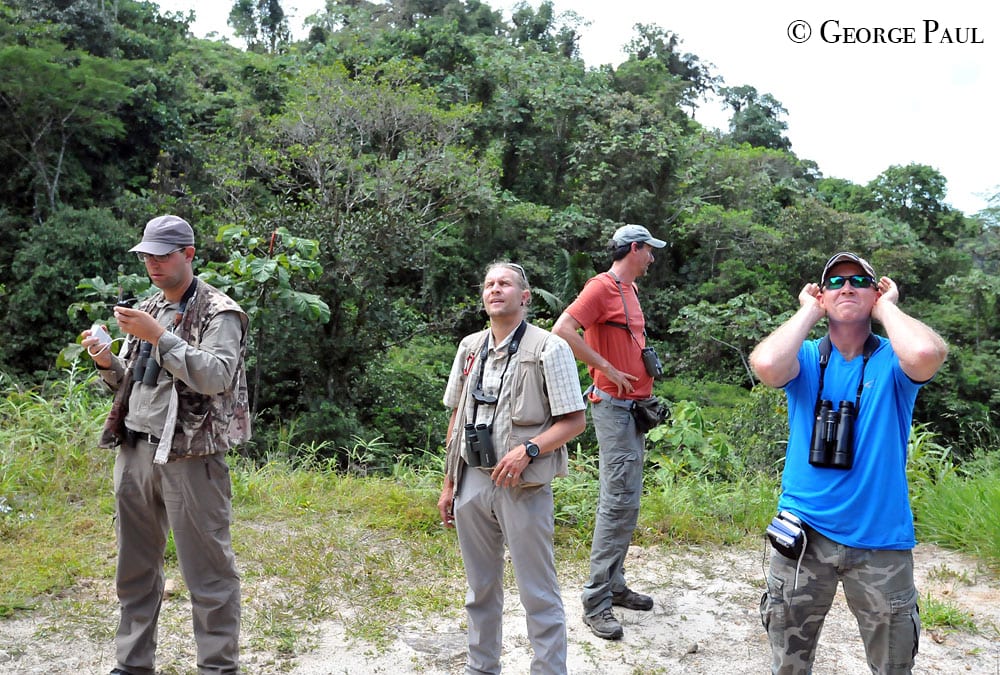
Summary of statistics
Our effort was conducted following the guidelines of the American Birding Association (ABA, link: http://listing.aba.org/big-day-count-rules/). ABA follows the rule that at least 95% of all species must be seen or heard by all members of the team. Our shared total was 415 species recorded by all four members (96.3%). We had 16 dirty birds, species missed by some of the team members (3.7%), that we were allowed to add to the grand total according to the 95% rule. A total of 305 species were visually seen (70.8%) and another 126 species (29.2%) were heard-only.
Family totals include 12 owls (including Barn Owl), 9 swifts, 27 hummingbirds, 8 parrots, 9 woodpeckers, 24 ovenbirds, 19 antbirds, 54 tyrant flycatchers, 9 swallows, 11 wrens, 52 tanagers and 10 New World Warblers. Rufous-banded Owl was the first species recorded and Snowy Plover was our final species of the count. Red-crested Cotinga was our world record breaking species (#355). As far as we know this has been the first big day effort that was documented during the full 24-hours with audio equipment. The total distance covered by vehicle was c. 385 km. Our highest elevation reached was at Papallacta Pass (4000m). The total species list can be viewed here:
https://www.researchgate.net/publication/283498360_World_Record_Big_Day_Ecuador_-_Data_report.
